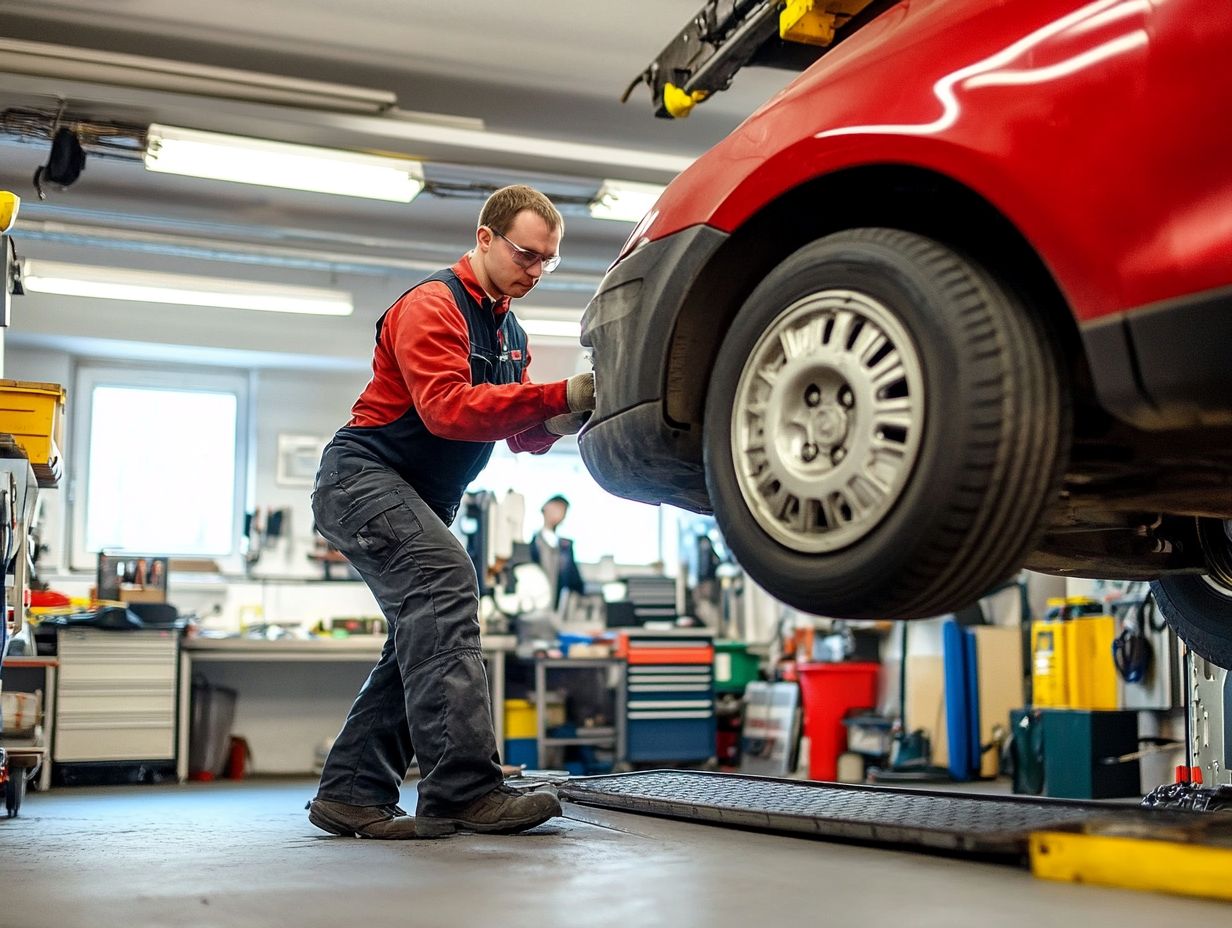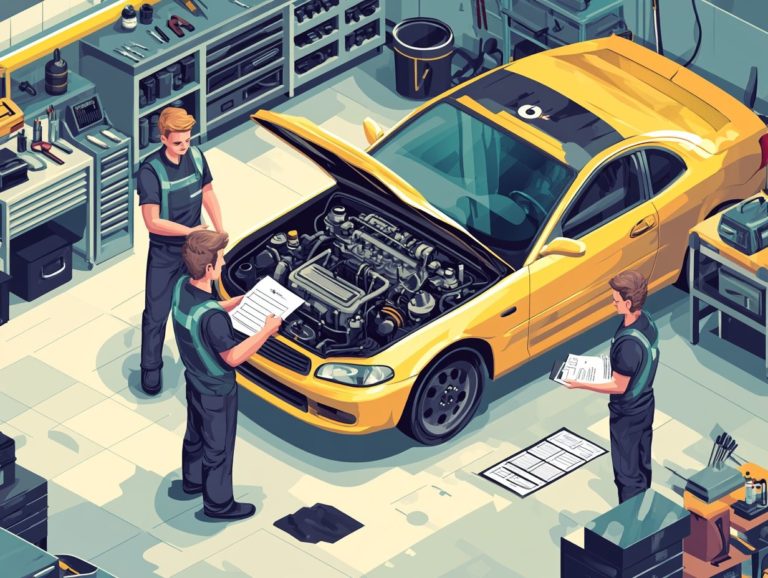Understanding the Importance of Tire Alignment
Tire alignment is an essential element of vehicle maintenance that often slips under the radar. When done correctly, it ensures your tires wear evenly and enhances handling. It also boosts fuel efficiency. Misaligned tires lead to many issues, ranging from uneven wear to compromised safety on the road. Don’t let small issues become big problems!
This article delves into the definition and purpose of tire alignment. It highlights common signs of misalignment, examines its impact on performance and safety, and offers practical tips for checking, adjusting, and maintaining proper alignment.
Understanding the importance of tire alignment can pave the way for a smoother, safer ride, whether you re a seasoned car enthusiast or simply someone who enjoys a casual drive.
- Proper tire alignment is crucial for safe and efficient driving, as it ensures optimal vehicle performance and prevents potential accidents.
- Signs of misaligned tires include uneven tread wear, steering wheel vibration, and pulling to one side. These should be addressed promptly to avoid further damage.
- Tire misalignment can be caused by various factors such as potholes, worn suspension components, and improper installation. Regular checks and adjustments by a professional or through DIY methods can correct it.
Contents
Key Takeaways:

What is Tire Alignment?
Tire alignment involves the careful adjustment of your vehicle’s suspension system, which is the system that controls how your car handles bumps and turns. This vital service impacts key factors like comfort, safety, and your vehicle’s overall performance.
By maintaining proper alignment, you improve handling characteristics and fuel efficiency. A well-aligned vehicle reduces tire wear and enhances your driving confidence, offering a smoother ride devoid of unwelcome vibrations or road noise caused by misalignment.
Definition and Purpose
Tire alignment is an essential service that adjusts the angles of your wheels to ensure they are perfectly parallel and correctly positioned in relation to your vehicle’s suspension system. This careful calibration is vital for extending the life of key components, as it directly affects how your vehicle handles various driving conditions.
When your tire alignment is off, you may experience uneven tire wear, which can impact traction and steering response. Misalignment can also put unnecessary strain on other parts of the suspension system, potentially leading to significant repair costs down the line.
Regular alignment checks aren t just recommended; they are crucial for maintaining optimal performance and ensuring your vehicle operates safely and efficiently. By making tire alignment a priority, you can enjoy a smoother ride and improved fuel efficiency.
Signs of Misaligned Tires
Misaligned tires can reveal themselves in various ways, such as uneven tire wear, vibrations that resonate through the steering wheel, and a noticeable increase in road noise while you re driving.
By recognizing these indicators early on, you can prevent further damage to your vehicle, ensuring both safety and optimal performance. Stay alert to these signs to keep your ride safe and smooth!
Common Indicators
Common signs that your tires might be misaligned include uneven wear patterns, a steering wheel that seems to have a mind of its own, and pesky vibrations or a tendency to drift to one side while you’re driving.
Addressing these indicators is essential for ensuring your vehicle’s safety and performance. Uneven tire wear can lead to premature replacement, putting a dent in your wallet and compromising traction especially when the weather takes a turn for the worse. An off-center steering wheel could hint at deeper issues within the suspension system, potentially impacting how your vehicle handles and its stability during turns.
Vibrations or pulling can be more than just annoying; they can distract you and make it harder to maintain control, increasing the risk of accidents. Act quickly to avoid costly repairs! By conducting regular checks and making timely alignment adjustments, you can significantly improve your driving comfort and extend the lifespan of your tires.
Effects of Misaligned Tires

The consequences of misaligned tires reach far beyond just a minor annoyance; they can profoundly influence your vehicle’s performance, safety, and overall driving expenses.
When your tires aren t aligned properly, you may experience diminished handling, accelerated tire wear, and increased fuel consumption. This not only compromises your driving experience but ultimately impacts the lifespan of your vehicle and your financial investment.
Impact on Vehicle Performance and Safety
Misalignment seriously diminishes your vehicle’s performance, jeopardizing safety and shortening tire life.
When your vehicle’s wheels aren’t properly aligned, you may notice uneven tire wear, poor handling, and less fuel efficiency issues that can be particularly concerning in emergency situations.
Research shows that misaligned wheels can reduce fuel efficiency by up to 10% and cut tire life by 25% or more. This leads to higher costs for vehicle owners. A study from the National Highway Traffic Safety Administration highlights that misalignment plays a significant role in many accidents, emphasizing the need for regular alignment checks to prevent problems.
By addressing alignment issues promptly, you can keep your vehicle running smoothly while enhancing safety for yourself and everyone else on the road.
Causes of Tire Misalignment
Tire misalignment can arise from several factors, such as encountering potholes, navigating rough driving conditions, or experiencing wear on the parts of your car that support its weight and help with handling. By understanding these causes, you can take proactive steps to maintain proper alignment and ensure a smoother, safer driving experience.
Factors that Contribute to Misalignment
Several factors can lead to tire misalignment, including pesky potholes, worn-out suspension angles, and uneven tire pressure.
Everyday driving situations can gradually create improper tire angles, affecting your vehicle’s dynamics. For instance, when you repeatedly encounter potholes, it doesn’t just rattle your tires; it can also jolt your vehicle’s suspension out of its optimal position, leading to further misalignment.
As suspension components wear down, they change how your tires make contact with the road, increasing the chances of uneven tire wear and compromised handling. Inconsistent tire pressure also worsens these issues tires that aren’t inflated evenly can create handling problems and reduce traction.
To mitigate these risks and ensure your vehicle performs at its best, it’s essential to regularly monitor your suspension system, check tire pressures frequently, and seek professional alignment services. Your safety and driving experience depend on it!
How to Check and Adjust Tire Alignment
You can check and adjust your tire alignment through several methods, whether you prefer the hands-on approach of DIY or the expertise of skilled technicians offering professional services.
Grasping how to accurately assess alignment is essential for ensuring your vehicle performs at its best.
DIY Methods and Professional Services

DIY methods for checking tire alignment can certainly be approached with simple techniques you can perform right at home. However, professional services bring advanced equipment and expertise to ensure a thorough alignment check.
If you re inclined toward a hands-on method, you might reach for tools like a tape measure or take your vehicle for a test drive, observing its steering behavior to identify any misalignment. While these methods can give you a rough idea of alignment issues, they don t match the precision offered by professional diagnostics.
On the flip side, choosing professional services means you benefit from specialized machinery and skilled technicians who can accurately diagnose and rectify alignment problems. While DIY approaches may be more budget-friendly and convenient, neglecting proper vehicle maintenance can lead to uneven tire wear and safety risks on the road.
Thus, investing in professional evaluations is a savvy choice for ensuring your vehicle’s long-term health and performance. Don t wait until it s too late! Make sure to check your alignment today!
Maintaining Proper Tire Alignment
Maintaining proper tire alignment is crucial for maximizing tire longevity, ensuring your safety, and enhancing your vehicle’s performance. Additionally, understanding the importance of tire pressure is vital for optimal tire care. By implementing regular tire care and alignment services, you can significantly elevate your driving experience, making it smoother and more enjoyable!
Tips for Ensuring Long-Term Alignment
To ensure long-term alignment, prioritize regular tire care, which includes regular rotation and periodic checks by professional services.
Sticking to a scheduled maintenance plan helps catch potential issues early, giving you the chance to make timely adjustments before they turn into larger problems. Using a tire pressure monitoring system is essential, as keeping the correct air pressure boosts fuel efficiency and promotes even wear.
Don t underestimate the power of visual inspections! Taking the time to check for uneven tread patterns or sidewall damage can make a significant difference. Ultimately, adopting a proactive approach to tire care not only extends the lifespan of your tires but also enhances safety and handling on the road.
Frequently Asked Questions
What is tire alignment and why is it important?
Tire alignment refers to the adjustment of the angles of the tires to ensure they are parallel to each other and perpendicular to the ground. Proper alignment improves fuel efficiency, extends the life of your tires, and enhances the handling and safety of your vehicle.
How often should I get my tires aligned?
It is recommended to get your tires aligned every 6,000 to 8,000 miles or whenever you notice signs of misalignment, such as uneven tire wear or your vehicle pulling to one side.
What causes tire misalignment?
Tire misalignment can be caused by various factors, including potholes, hitting curbs, regular wear and tear, and suspension issues. Even minor misalignments can lead to major problems, so it is important to have your tires checked regularly.
What are some signs that my tires may need to be aligned?
Common signs of misaligned tires include uneven or rapid tire wear, steering wheel vibration, pulling to one side while driving, and a crooked steering wheel when driving straight.
Can I align my tires myself?
While it’s possible to align your tires yourself, it is not recommended. Proper tire alignment requires specialized equipment and knowledge, so it’s best to leave it to a professional mechanic!
How much does tire alignment typically cost?
The cost of tire alignment can vary depending on the make and model of your vehicle, but on average, it can range from $50 to $100. The cost may increase if additional adjustments or parts are needed.
Don’t wait check your tires today for a safer ride!







